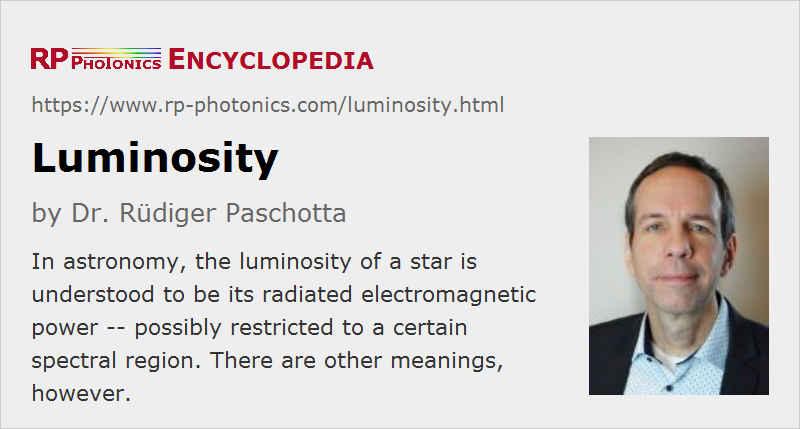Luminosity
Definition: radiant flux (among other meanings)
German: Luminosität
Categories:  light detection and characterization,
light detection and characterization,  vision, displays and imaging
vision, displays and imaging
Author: Dr. Rüdiger Paschotta
Cite the article using its DOI: https://doi.org/10.61835/6x9
Get citation code: Endnote (RIS) BibTex plain textHTML
The term luminosity is used with different meanings. In a astronomy, it can mean the electromagnetic power radiated by an object such as a star and may be specified with units of watts, or alternatively relative to the emission of the Sun (solar luminosities). If radiation from all spectral region is taken into account, that quantity would more specifically called the bolometric luminosity. One may also consider only radiation in certain limited spectral regions, such as visible light, ultraviolet light or X-rays, for example, to obtain quantities like an X-ray luminosity. In radiometry, one would actually call such quantities the radiant flux or radiant power.
The initial letters “lumi” (from Latin luminare = to illuminate) may seem to suggest that luminosity is a term of photometry (e.g. like luminous flux or luminance), where the spectral response of the human eye is taken into account. That is usually not the case, however – except in the context of luminosity functions, specifying the spectral sensitivity of the human eye.
An entirely different meaning is used in the area of scattering theory and particle accelerators: there, the luminosity of a particle beam times an interaction cross-section (e.g. of a bombarded particle) delivers the rate of interaction processes. A high luminosity of a particle accelerator – implying a small beam cross-section and not only a high particle current – is often desired for investigating processes with small interaction cross-sections.
More to Learn
Encyclopedia articles:
Questions and Comments from Users
Here you can submit questions and comments. As far as they get accepted by the author, they will appear above this paragraph together with the author’s answer. The author will decide on acceptance based on certain criteria. Essentially, the issue must be of sufficiently broad interest.
Please do not enter personal data here; we would otherwise delete it soon. (See also our privacy declaration.) If you wish to receive personal feedback or consultancy from the author, please contact him, e.g. via e-mail.
By submitting the information, you give your consent to the potential publication of your inputs on our website according to our rules. (If you later retract your consent, we will delete those inputs.) As your inputs are first reviewed by the author, they may be published with some delay.


Connect and share this with your network:
Follow our specific LinkedIn pages for more insights and updates: